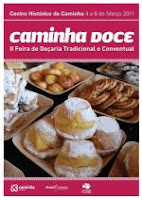 |
| A "body of Christ" pastry minus one bite |
I love how the Portuguese name their sugary treats!! A few weeks ago, we split a tambor, which means drum. It looks just like a drum, with lots of layers of flaky pastry, cream filling and a dusting of powdered sugar. One of my favorites is guardanapo, which means napkin and looks just like a square napkin folded in half along the diagonal (cream filling w/ sugar & cinnamon on top!!) and tibia which, well, looks like a leg bone (slightly bulbous at the ends and straight in the middle, usually filled like an eclair w/ powdered sugar on top). Sometimes tibia are slit open and topped with whipped cream and shreds of cooked egg yolk - they look just like loaded baked potatoes.
 |
| A "napkin" at São João |
There are also caracóis (snails), toucinho do ceu (pig heaven), almofadas and travesseiros (2 different words for pillows), a runny pudding called baba de camelo (camel slobber) and many, many more. Travesseiros are rolled pastries with candied spaghetti squash inside (better than it sounds!) and sprinkled with toasted coconut. They're so sweet they make my teeth tingle!! Toucinho do ceu does actually translate to 'pig heaven' or 'bacon from heaven' - a sweet almond pastry that traditionally was made with bacon or lard.
 |
| This bundle of pumpkiny goodness is dedicated to St. Lucy |
We've been eating our way through the Portuguese specialties, but there are so many. Every little town and convent has their own special sweets. It's truly mind-boggling!!
Tuesday was a national holiday for Carnaval. The university was closed, so Eric worked at home while I ventured to Caminha, a small town on the Minho river at the point where it flows into the Atlantic Ocean. Towards the end of the 2 hour train ride I had great views of the ocean, and when I arrived in Caminha I could see Spain across the river!!
Caminha was hosting a 5 day traditional and convent sweets festival called Caminha Doce. There were big tents set up to house the various bakeries and vendors - one for traditional regional sweets and the other for convent sweets.
Different from traditional regional sweets, convent sweets are a distinct category of sugary treats. Here's the scoop from Rick Steves: Portugal once had access to more sugar than any other European country. Even so, sugar was so expensive that only the aristocracy could afford to enjoy it routinely. Historically, daughters of aristocrats who were unable to marry into noble families ended up in high-class convents. Life there was comfortable, yet carefully controlled. Rather than romance, they could covet and treat themselves with sweets. Over time, the convents became famous as keepers of secret recipes for exquisite pastries generally made from sugar and egg yolks (which were leftovers from egg whites used to starch their habits). ** Thank you Rick! **
 |
| Irreverent yet delicious Sacristans' Balls |
Future visitors to Portugal may want to study this link or this one and be ready to try some Abbots' Ears, Novices' Boobs and Nuns' Necks!!
~ Peggy

No comments:
Post a Comment